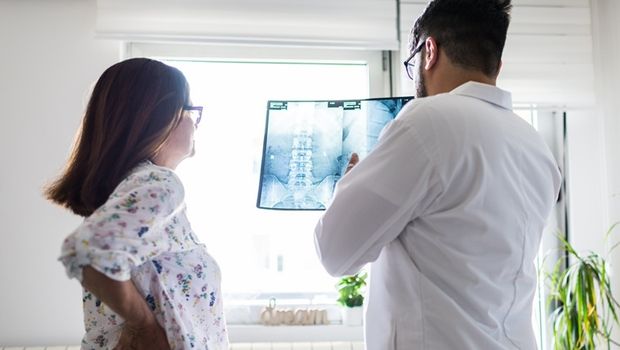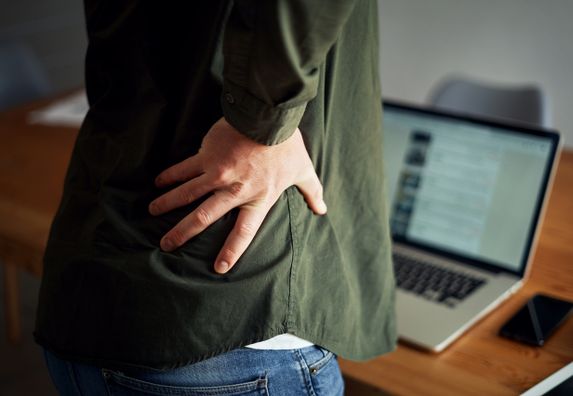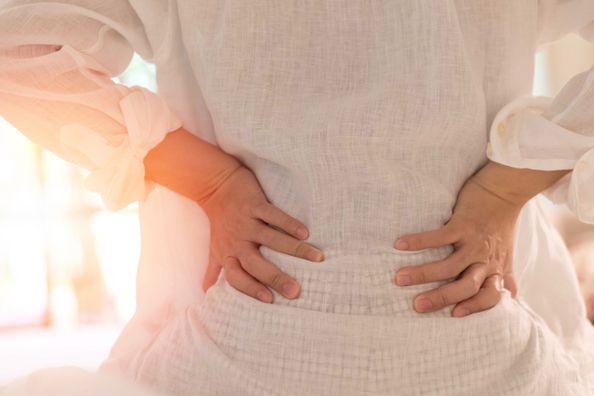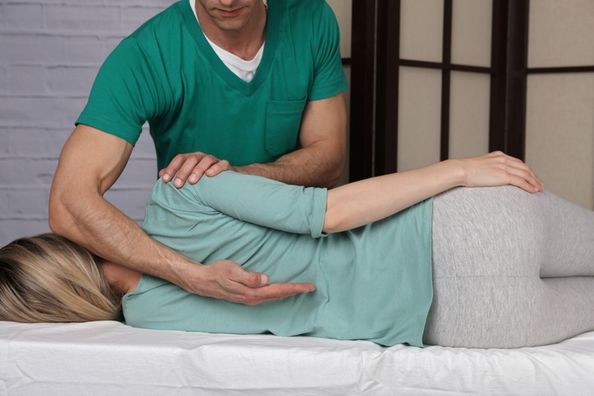Probiotic yogurts, prebiotic sodas, daily gut health supplements…gut-friendly products line the shelves of grocery stores, and gut health has become a hot topic of conversation in the wellness world.
There’s a good reason for it. The gut microbiome is an environment of trillions of tiny organisms, including bacteria, viruses, fungi, and parasites that live in your gut. If your gut microbiome becomes imbalanced or unhealthy, it’s called dysbiosis. This imbalance or dysbiosis can result from bacterial overgrowth, loss of beneficial bacteria, or loss of bacterial diversity. Several causes for dysbiosis have been identified, including smoking, alcohol use, antibiotics/antimicrobials, toxins, chronic conditions, chronic inflammation, and even certain types of foods.
At a Glance: Gut Microbiome & Spine Health
- Gut dysbiosis (imbalance of gut bacteria) can result from lifestyle, medications, or chronic conditions and affects overall health.
- An unhealthy gut microbiome has been linked to digestive problems, mood disorders, chronic disease, and even spine issues.
- Recent research connects gut microbiome changes to lumbar degenerative spondylolisthesis (LDS), a lower-back condition.
- Studies show people with LDS may have higher levels of inflammatory bacteria and lower levels of protective bacteria.
- After a spinal cord injury (SCI), gut bacteria can shift (lowering beneficial strains and increasing harmful ones), which fuels inflammation and related health risks.
- The only way to know how your gut and spine are interacting is to talk with your healthcare provider.
Gut dysbiosis can affect your whole body and has been linked to problems like malnutrition, metabolic syndrome, chronic disease, mood disorders, and digestive issues.
Those are some of the more well-known effects of gut dysbiosis. But there’s an often-overlooked part of your body that’s connected with an unhealthy gut microbiome: your spine.
Also read: Probiotics and Prebiotics: Helpful Bugs for Your Gut
What’s the Connection Between the Gut Microbiome and the Spine?
The connection between the gut microbiome and the spine goes both ways. Gut dysbiosis may put you at risk for spine problems, while spine problems or injuries may also affect your gut microbiome.
The relationship between the gut microbiome and spine health is still a relatively new area of research. There have recently been two major developments in the field: the connection between the gut microbiome and lumbar degenerative spondylolisthesis, and how bacterial flora in the gut can change after a spinal injury.
The Gut Microbiome and Lumbar Degenerative Spondylolisthesis (LDS)
Spondylolisthesis is when one of your spine bones, a vertebra, moves out of alignment with the surrounding vertebrae. The most common cause is degenerative. This is when the discs between the vertebrae that cushion your joints start to break down as you age as a result of normal wear and tear.
Degenerative disease of the spine begins at the intervertebral disc. As the disc degenerates, the space between the vertebrae is narrowed. This can lead to weakness of the surrounding ligaments and result in the instability that we see in spondylolisthesis. Lumbar degenerative spondylolisthesis (LDS) is specifically referring to spondylolisthesis in the lumbar spine, which is located in the lower back. Depending on the severity of the patient’s symptoms or the level of instability, LDS can require surgical intervention.
A Word from Our Doctor:
“Spondylolisthesis is one of the more common diagnoses that we see in our practice. Staying up to date on the most recent literature is crucial to providing our patients with the best care possible.”
- Ashish Patel, MD, Board Certified Orthopaedic Surgeon with Duly Health and Care, Member of the American Academy of Orthopaedic Surgeons, North American Spine Society, and Scoliosis Research Society
While there have been many causes of LDS identified, recent studies have questioned the role of the gut microbiome on this disease process. A 2024 study looked at differences in the gut microbiome between people with and without LDS. It was a small study, and among the first of its kind, but the results were striking.
When researchers compared those with and without LDS, there was no statistical difference when it came to factors like age, weight, sex, diet, and pain. The major difference between these groups that this study found was the gut microbiome. While the difference in bacterial profiles across these groups was statistically significant, the causality has not been identified.

Also read: The Aging Spine
There are major spikes in certain types of bacteria in people with LDS. The ratio of Firmicutes-to-Bacteroidota (F/B) has been linked to metabolic and inflammatory conditions. The heightened inflammatory state caused by the F/B ratio could contribute to the degenerative changes seen in LDS.
Since the research is very limited, it’s too early to say with 100% certainty why gut microbiome dysbiosis is associated with LDS. Researchers have theorized that the gut microbiome could potentially:
- Stimulate inflammation, which can lead to LDS. In the 2024 study, LDS patients had higher levels of bacteria known to trigger inflammation and lower levels of ones that help reduce inflammation.
- Expose you to an invasion of bacteria that promote inflammation.
- Alter your metabolism. Bacteria in the gut may change how you metabolize medications. This, in theory, could make a patient less responsive to certain medications that manage back pain.
The Gut Microbiome After a Spinal Cord Injury (SCI)
A spinal cord injury (SCI) doesn’t just cause back pain, it can affect various parts of your body. SCIs can cause a cascade of additional symptoms, ranging from bladder problems like incontinence, to paralysis of all four limbs.
As a result of complications after a SCI, some patients experience secondary causes of inflammation, like pressure ulcers and urinary tract infections, which can raise the risk of other medical problems. For instance, evidence has shown that patients with a SCI have a significantly higher risk of heart disease, which may be attributed to the chronic inflammation from secondary complications.
Inflammation is one place where the gut microbiome comes in. Recent studies have found that the bacteria in the gut may change after you get a SCI. Certain beneficial bacteria can decrease, while more harmful ones can increase – and this change in bacterial flora could be related to a heightened inflammatory state.
This can lead to a whole host of possible health problems. For example, people with SCI might see an increase in Prevotellaceae bacteria, which has been associated with rheumatoid arthritis and high blood pressure. At the same time, they may have lower levels of the Bacteroidaceae bacteria, which has been linked with inflammatory bowel disease (IBD).
As with the connection of the gut microbiome to LDS, the connection with SCIs still isn’t completely understood. There are many theories, but there are also plenty of questions to be answered.
Also read: The Prebiotic Soda Trend
What to Do If You Suspect Gut Health Problems
There are some home tests to check your gut microbiome health, but the only way to know for sure how your gut microbiome and spine are interacting is to talk to your provider. If you think there may be a problem, don’t hesitate to get help. Go with your gut.
If you suspect gut health issues, start by scheduling with a Duly Health and Care gastroenterologist. They’ll review your health history and symptoms, may recommend testing, and if needed, will coordinate with our spine surgeons to create a treatment plan.
Find a gastroenterologist near you >
Health Topics:





